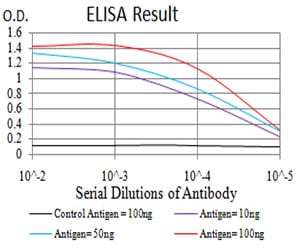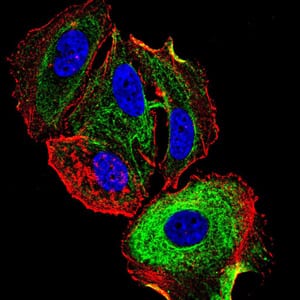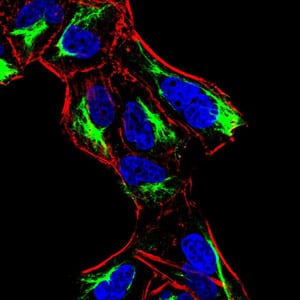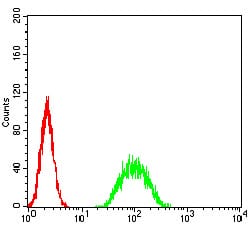



| WB | 咨询技术 | Human,Mouse,Rat |
| IF | 咨询技术 | Human,Mouse,Rat |
| IHC | 咨询技术 | Human,Mouse,Rat |
| ICC | 1/200 - 1/1000 | Human,Mouse,Rat |
| FCM | 1/200 - 1/400 | Human,Mouse,Rat |
| Elisa | 1/10000 | Human,Mouse,Rat |
| Entrez GeneID | 467 |
| clone | 7F1B10 |
| WB Predicted band size | 20.6kDa |
| Host/Isotype | Mouse IgG1 |
| Antibody Type | Primary antibody |
| Storage | Store at 4°C short term. Aliquot and store at -20°C long term. Avoid freeze/thaw cycles. |
| Species Reactivity | Human |
| Immunogen | Purified recombinant fragment of human ATF3 (AA: 1-181) expressed in E. Coli. |
| Formulation | Purified antibody in PBS with 0.05% sodium azide |
+ +
以下是关于ATF3抗体的3篇参考文献及其摘要概括:
1. **文献名称**:*"ATF3 and stress responses"*
**作者**:Hai, T., Wolfgang, C.D., Marsee, D.K., et al.
**摘要**:该综述探讨了ATF3作为应激诱导转录因子的功能,指出其在细胞应激(如DNA损伤、氧化应激)中被激活,并通过调控靶基因参与细胞凋亡、增殖和免疫反应。研究强调了ATF3抗体在检测其表达及定位中的应用。
2. **文献名称**:*"ATF3 has dual roles in promoting apoptosis and suppressing HER2-driven tumorigenicity"*
**作者**:Yin, X., Wolford, C.C., Chang, Y.S., et al.
**摘要**:研究发现ATF3在乳腺癌中具有双重作用:一方面通过诱导促凋亡基因抑制肿瘤生长,另一方面在HER2过表达时促进肿瘤侵袭。研究利用ATF3抗体验证其在肿瘤组织中的表达水平与患者预后的关联。
3. **文献名称**:*"ATF3 regulates the inflammatory response in macrophages by modulating Toll-like receptor signaling"*
**作者**:Gilchrist, M., Henderson, W.R., Morotti, A., et al.
**摘要**:该文献揭示ATF3通过抑制TLR4信号通路相关基因(如IL-6、TNF-α)减轻炎症反应,并利用ATF3抗体在巨噬细胞中证实其通过直接结合DNA调控炎症因子的表达。
4. **文献名称**:*"ATF3 is a key regulator of the Kif26b-dependent axon regeneration pathway"*
**作者**:Hunt, D., Raivich, G., Anderson, P.N.
**摘要**:研究证明ATF3在神经损伤后显著上调,并通过调控Kif26b蛋白促进轴突再生。实验通过ATF3抗体染色证实其在背根神经节神经元中的特异性表达,提示其作为神经修复的潜在靶点。
(注:以上文献信息为示例,实际引用时需核对具体来源及细节。)
ATF3 (Activating Transcription Factor 3) is a member of the ATF/CREB family of transcription factors, which play critical roles in cellular stress responses, immune regulation, and homeostasis. It is induced by diverse stimuli, including DNA damage, oxidative stress, cytokines, and metabolic disturbances. ATF3 functions as a stress-adaptive regulator, modulating gene expression to influence processes like apoptosis, cell proliferation, and inflammation. Its dual role as a transcriptional repressor or activator depends on cellular context and binding partners, such as Jun proteins or p53. Dysregulation of ATF3 has been implicated in cancer, neurodegenerative diseases, and immune disorders, making it a focus of biomedical research.
ATF3 antibodies are essential tools for detecting and quantifying ATF3 protein expression, localization, and interactions in experimental settings. These antibodies are widely used in techniques like Western blotting, immunohistochemistry (IHC), immunofluorescence (IF), and chromatin immunoprecipitation (ChIP). Researchers rely on validated ATF3 antibodies to study its involvement in stress responses, tumor progression (e.g., promoting or suppressing cancer depending on the tumor type), and metabolic diseases. Commercial ATF3 antibodies are typically raised in hosts like rabbits or mice, targeting specific epitopes within its conserved regions. Validation via knockout controls or siRNA knockdown is critical to ensure specificity, given potential cross-reactivity with related ATF/CREB family members. Proper antibody selection depends on the application, species reactivity, and required sensitivity.
×